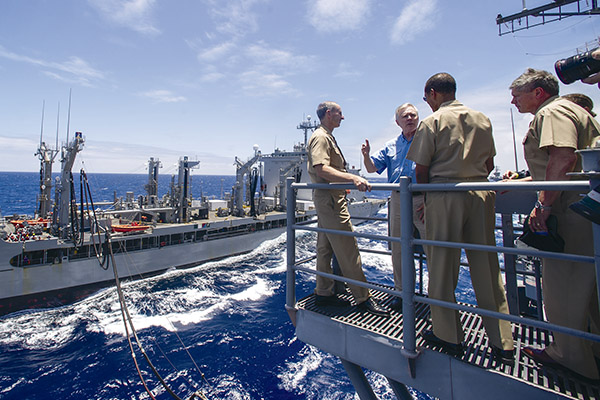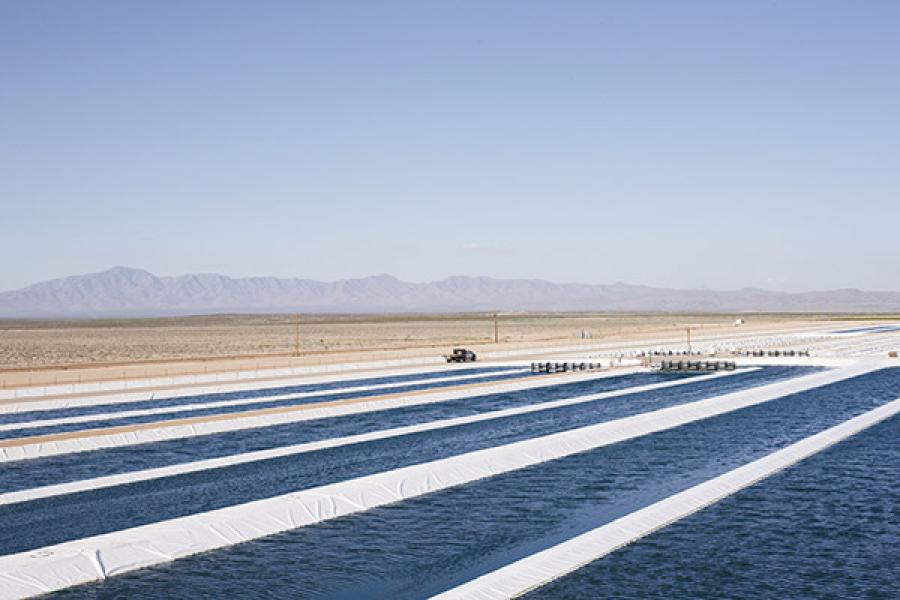
Startups and US Navy's Biofuel Programme
As the US Navy embarks on a financially dubious biofuel programme, a host of startups are eager to cash in
Eighty miles west of El Paso, Texas, in a sunburnt stretch of the New Mexico desert, Predator drones and blimps patrol the nearby border and immigration-agency SUVs speed through the desolate terrain, the occasional coyote loping across the scrub. Oddly, given that I’m more than 600 miles from the Pacific, there’s a distinct salty ocean tang wafting on the breeze. But that’s not the sea I’m smelling: The odour is emanating from algae growing in 30 acres of huge oblong ponds at Sapphire Energy’s Green Crude Farm.
Funded with $85 million from Bill Gates and other investors—plus $104 million in government cash and loan guarantees—the world’s only com- mercial outdoor algal biorefinery went online this summer and will eventually expand to 300 acres. The plan: Extract 1.5 million gallons of green crude oil a year from patented pond scum fed a diet of carbon dioxide and sunlight.
Even before San Diego-based Sapphire broke ground on the demonstration plant last year, the US Navy’s green energy warrior, Vice Admiral Philip Cullom, descended on the desert site to grill Sapphire execs on their technology and its potential to fuel battleships and jet fighters. “No question, the military has focussed the company and given us a great challenge to meet,” says Sapphire executive Tim Zenk, standing on the catwalk of a tank.
Scum ponds in the desert? The very idea conjures memories of the federal government’s decidedly mixed record at promoting alt-energy projects: Solyndra, FutureGen, A123’s electric-car batteries, synfuels in the 1980s, jojoba in the 1970s. Add to that all the many military boondoggles—Star Wars missile defence, for one—born of best intentions and bloated budgets.

Secretary of the Navy Ray Mabus (in blue shirt) aboard the USS Princeton, as it loads up with biofuel from the USNS Henry J Kaiser
Sapphire has yet to earn a dime from the Pentagon; the company’s government funding comes from the Departments of Energy and Agri- culture. But since the days when the startup’s scientists were still tinkering in the lab, they’ve been sending their biofuel for evaluation to the Department of Defense (DOD), the deepest-pocketed client of them all. “There’s no other entity that has the capacity, the plan- ning, the commitment and the policy drivers to make technologies real and create a market,” says Zenk.
The US military, the nation’s single largest oil consumer, wants to wean itself from petroleum, and is deploying its immense buying power to commer- cialise nascent technologies deemed to be in the national interest.
The Navy, which aims to get half of its energy from renewable sources by 2020, has been buying biofuels in small but expensive quantities, as in four times the cost of conventional fuels. That has outraged some con- gressional Republicans, who intend to bar the military from buying any fuel that costs more than petroleum.
It will be years before we know if the military’s biofuels bet is a multi-billion-dollar folly—or if the armed forces have planted the seeds of another global industry, as it did with nuclear power, semiconductors and the internet. This much is certain: The Pentagon’s largesse is already spurring the entrepreneurial zeal of startups like Sapphire that seek potential riches in shaping green technology to meet military needs.
In July, off the coast of Hawaii, the Navy floated its intentions with the launch of the Great Green Fleet, the first Navy strike force powered by a 50-50 blend of standard aviation fuel and a mixture of algae and used cooking oil. Some 450,000 gallons of that biofuel, produced by Solazyme and Dynamic Fuels, powered the F/A-18 fighter jets screaming through the skies, the E-2C Hawkeyes patrolling the surrounding airspace and the Seahawk helicopters ferrying Secretary of the Navy Ray Mabus and top Navy brass between two destroyers and a guided missile cruiser steaming alongside the nuclear-powered USS Nimitz.
Mabus is determined to build an energy-independent flotilla by 2016. “We’re moving forward and we’re not going to let up,” says Vice Admiral Cullom, the deputy chief of naval operations for fleet readiness and logistics.
Solazyme, based in South San Francisco’s biotech corridor, grows heterotrophic algae in bioreactors. After Solazyme began supplying the military with small quantities of algae biofuels for evaluation, the DOD awarded the company its first significant contract in 2010. The next year, a United Airlines 737 flew the first commercial biofueled flight on Solayzme’s Solajet fuel. “The fact that we could even make that United flight was a direct result of the work we had been doing with the Navy,” says Jonathan Wolfson, Solazyme’s chief executive.
The military work also spurred discoveries of new strains of algae, which explains why next to its re- search labs Solazyme built a kitchen to bake up batches of chocolate chip cookies, honey mustard dipping sauce and crackers. While testing strains, Solazyme scientists found one that produces what tastes remarkably like olive oil but is healthier and could replace eggs and butter in a smorgasbord of foods. “Your mouth recognises it as fat, but it has a remarkable reduction in calories and eliminates saturated fats,” says Genet Garamendi, Solayzme’s vice president of corporate communications.
Solazyme struck deals to com-mercialise its Betty Crocker crude with Unilever and Roquette, the French food conglomerate. In May, Dow Chemical said it would tap a strain of Solazyme algal oil for use in electrical transformer insulating fluids.
Michael McAdams, president of the Advanced Biofuels Association, says at least a dozen of his 45 member companies are expected to put in bids to tap $210 million in DOD funding to build biorefineries. Whether the biofuels industry can scale up to provide the eight million barrels the Navy needs annually—at a price Uncle Sam can afford—is the big unknown. A report prepared by the Rand Corp for the Secretary of Defense last year bluntly concluded that the military would not be able to secure sufficient supplies of biofuels at a competitive price.
Sierra Energy, the startup, based in Davis, California, is developing technology to transform a blast furnace into a machine that can vapourise garbage and produce either diesel fuel or electricity. It’s a decidedly low-tech-looking metal cylinder connected to a conveyer belt that feeds the contraption a diet of discarded bottles, plastic, metal and other detritus. Oxygen and steam injected into the cylinder’s base incinerates the trash, leaving a gas that can be refined into diesel. The possibility of using such technology on remote battlefield bases caught the Marines’ attention and changed Sierra’s business plan.
“The Marine Corps said, ‘Make it modular so it can be delivered in the field,’ and they wanted us to produce liquid fuels, so that’s what we did,” says Sierra Chief Executive Michael Hart, pointing to a prototype being tested at a decommissioned Air Force base outside Sacramento.
Hart is betting that if he meets the Marines’ needs he can capture a potentially lucrative military market—and sell to cities seeking to generate renewable energy while slashing landfill bills.
“The DOD is serious as a heart attack,” he says. Sapphire hasn’t priced its algal oil yet, but the company expects it to be competitive with petroleum by 2018 if it can produce a minimum of 5,000 barrels a day, according to Zenk. “I don’t want to oversell to you—there are a lot of challenges ahead of us,” says Zenk. “But every energy transition has been led by our government and primarily it’s been military-driven, and the same is true this time.”
(This story appears in the 26 October, 2012 issue of Forbes India. To visit our Archives, click here.)
-
 Alan
AlanNice info.
on Oct 20, 2012 -
 Piyush
PiyushGood article.
on Oct 20, 2012
















